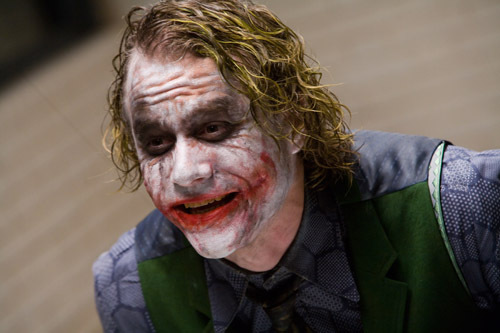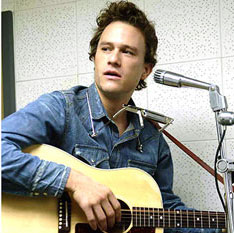“Most of the time, I’m halfway content. Most of the time, I know exactly where it all went.” Maybe it’s the impending holidays. Maybe it’s dissertoral stress. Or maybe it’s the weather, or something like that. Still, it was one of those weekends…So, in light of that, Bob Dylan’s “Most of the Time” meets Eternal Sunshine of the Spotless Mind. I never would have chosen this sort of hermit life for myself. But, given this is the hand I’m currently playing, at least there’re great movies and great music on my side.
Category: Bob Dylan
His Back Pages.
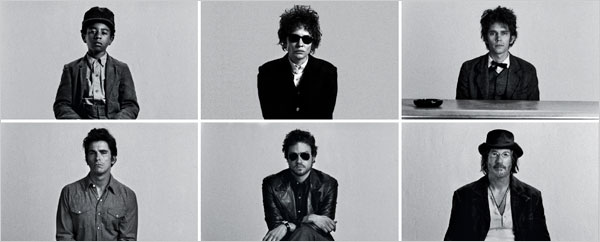
“A song will lift, as the mainsail shifts, and the boat drifts on to the shoreline.” If you’ve been reading this site for any length of time, you probably already know that I drank the Bob Dylan kool-aid a good while ago. So, more than likely, my opinion of Todd Haynes’ I’m Not There, which I raced down (on the D-train, no less) to catch at the Film Forum this morning, should be taken with at least a shaker of salt. And, to be honest, it’s hard to imagine how this film plays to people who aren’t all that into Dylan — If you don’t already have a basic sense of his story and his various periods, I could see it being as incoherent and irritating as Southland Tales (although it’s assuredly better-made.) But, if you do have any fondness for Bob, oh my. The short review is: I loved it. Exploding the conventional music biopic into shimmering, impressionistic fragments, Todd Haynes has captured lightning in a bottle here. The movie is clearly a labor of love by and for Dylan fans, riddled with in-jokes, winks, and nods, and I found it thoughtful, funny, touching, and wonderful. Put simply, while No Country for Old Men is right up there, I’m Not There is my favorite film of the year. I can’t wait to see it again.
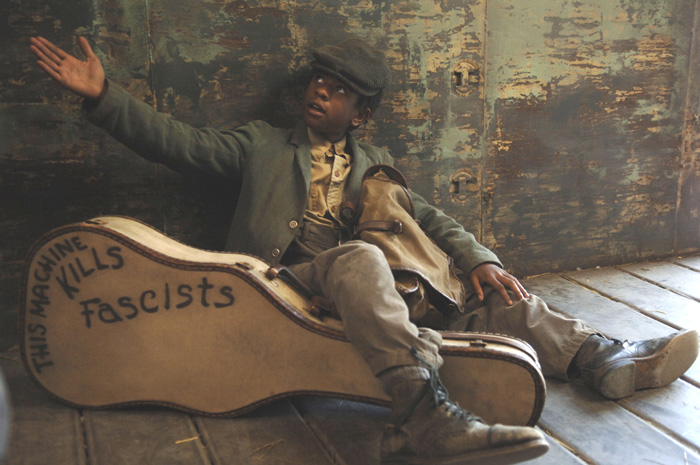 Like Navin Johnson, Bob Dylan was born a poor black child. (Marcus Carl Franklin) Ok, perhaps not. But Hayne’s movie doesn’t really aim to tell the story of one Robert Zimmerman of Hibbing, Minnesota. anyway. — He’s not there. Instead I’m Not There refracts Dylan through a prism of sorts, giving us multiple versions of the man (and myth) at various stages in his life and work. And, so, after a first person POV shot of “Dylan” (us?) taking the stage in ’66, and a title shot involving a potentially-momentous motorcycle, we are introduced to one Woody Guthrie (Franklin), an 11-year-old folk wunderkind traveling hobo-style along the rails, singing union songs and making up his past as he goes along. But the times they-are-a-changin’, and, as a kindly matron informs Woody, the old songs don’t necessarily do justice to the problems of 1959. Enter Jack Rollins (Christian Bale), an earnest young troubador who once lit Greenwich Village on fire with his ballads of social protest (“finger-pointin’ songs”), and, having rejected the folk scene and found Jesus, is now the subject of a No Direction Home-style documentary. (Julianne Moore does a Joan Baez impression here, straight out of Scorsese’s doc, which is pretty hilarious, and maybe even a little mean — note the business with the cat.)
Like Navin Johnson, Bob Dylan was born a poor black child. (Marcus Carl Franklin) Ok, perhaps not. But Hayne’s movie doesn’t really aim to tell the story of one Robert Zimmerman of Hibbing, Minnesota. anyway. — He’s not there. Instead I’m Not There refracts Dylan through a prism of sorts, giving us multiple versions of the man (and myth) at various stages in his life and work. And, so, after a first person POV shot of “Dylan” (us?) taking the stage in ’66, and a title shot involving a potentially-momentous motorcycle, we are introduced to one Woody Guthrie (Franklin), an 11-year-old folk wunderkind traveling hobo-style along the rails, singing union songs and making up his past as he goes along. But the times they-are-a-changin’, and, as a kindly matron informs Woody, the old songs don’t necessarily do justice to the problems of 1959. Enter Jack Rollins (Christian Bale), an earnest young troubador who once lit Greenwich Village on fire with his ballads of social protest (“finger-pointin’ songs”), and, having rejected the folk scene and found Jesus, is now the subject of a No Direction Home-style documentary. (Julianne Moore does a Joan Baez impression here, straight out of Scorsese’s doc, which is pretty hilarious, and maybe even a little mean — note the business with the cat.)
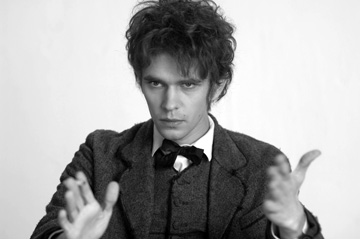 By now, you probably see where this is going. Post-Newport, Cate Blanchett shows up as Jude, a.k.a. the reedy, combative, drugged-out, and dog-tired Dylan of (blonde on) Blonde on Blonde and Don’t Look Back. (It takes a woman like her, to get through, to the man in him.) Ben Whishaw shares the load of society’s probing as Arthur Rimbaud, a Bob who spends most of the movie facing down some unknown interlocutors. Heath Ledger’s Robbie is the romantic and the womanizer, the Dylan who woos the heartbreakingly beautiful Claire (Charlotte Gainsbourg, playing an amalgamation of Suze Rotolo and Sara Lownds), looks for solace in a normal life outside Woodstock, and eventually stares into the abyss of Blood on the Tracks. And Richard Gere is Billy, an aging outlaw hiding out in Riddle, MO, part of the mythical American landscape conjured by Bob in “Bob Dylan’s 115th Dream,” “Desolation Row,” John Wesley Harding, The Basement Tapes, “Blind Willie McTell,” and countless other songs.
By now, you probably see where this is going. Post-Newport, Cate Blanchett shows up as Jude, a.k.a. the reedy, combative, drugged-out, and dog-tired Dylan of (blonde on) Blonde on Blonde and Don’t Look Back. (It takes a woman like her, to get through, to the man in him.) Ben Whishaw shares the load of society’s probing as Arthur Rimbaud, a Bob who spends most of the movie facing down some unknown interlocutors. Heath Ledger’s Robbie is the romantic and the womanizer, the Dylan who woos the heartbreakingly beautiful Claire (Charlotte Gainsbourg, playing an amalgamation of Suze Rotolo and Sara Lownds), looks for solace in a normal life outside Woodstock, and eventually stares into the abyss of Blood on the Tracks. And Richard Gere is Billy, an aging outlaw hiding out in Riddle, MO, part of the mythical American landscape conjured by Bob in “Bob Dylan’s 115th Dream,” “Desolation Row,” John Wesley Harding, The Basement Tapes, “Blind Willie McTell,” and countless other songs.
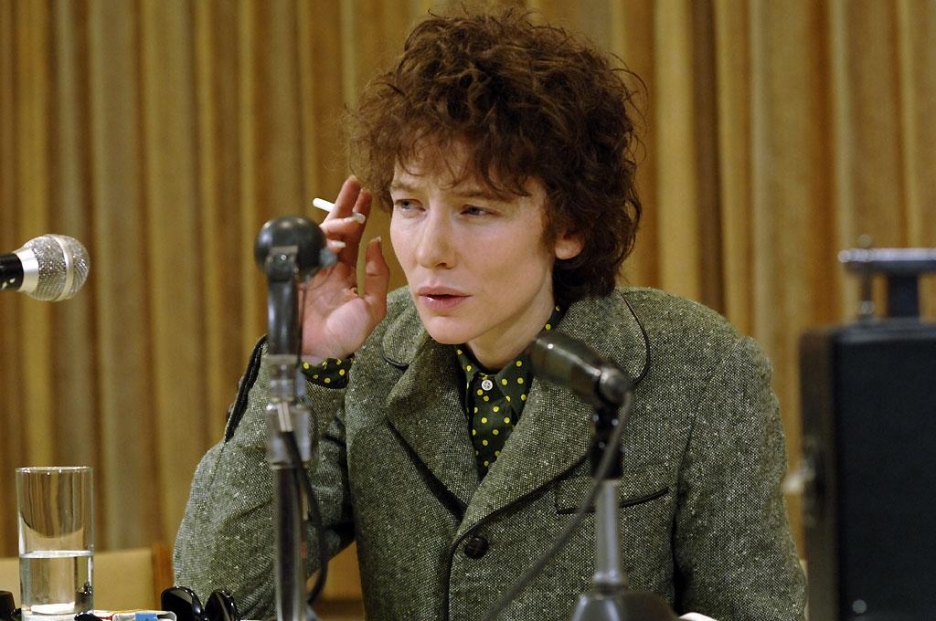 Each of this fellowship of Dylans does quality work in the role. Cate Blanchett is getting the most press these days, perhaps deservedly so, but I was as impressed with Bale, Whishaw, Franklin, and particularly Ledger — After seeing the extent of his range here, it’s pretty clear he’s going to kill as the Joker next summer. And other actors resonate here as well. I already mentioned Julianne Moore and the exquisite Charlotte Gainsbourg. (My crush on the latter, already simmering after The Science of Sleep, will no doubt grow by leaps and bounds now, particularly once you factor in her fragile, breathy version of “Just Like a Woman” on the soundtrack. With a face that’s at once honest, open, statuesque, and melancholy, she’s the perfect sad-eyed lady of the lowlands.) Also notable is David Cross, the spitting image of Allen Ginsberg, Michelle Williams invoking Factory Girl Edie Sedgwick, and a well-preserved Richie Havens delivering a Joe Cocker moment with his version of “Tombstone Blues.” Bruce Greenwood (of Thirteen Days, The Sweet Hereafter, and recently John from Cincinnati) does particularly impressive work as Jude’s nemesis, a BBC newsman who wants to pin both the mercurial singer and the meaning of his (her) music to the wall like a butterfly. Clearly, something is happening here, but he don’t know what it is…
Each of this fellowship of Dylans does quality work in the role. Cate Blanchett is getting the most press these days, perhaps deservedly so, but I was as impressed with Bale, Whishaw, Franklin, and particularly Ledger — After seeing the extent of his range here, it’s pretty clear he’s going to kill as the Joker next summer. And other actors resonate here as well. I already mentioned Julianne Moore and the exquisite Charlotte Gainsbourg. (My crush on the latter, already simmering after The Science of Sleep, will no doubt grow by leaps and bounds now, particularly once you factor in her fragile, breathy version of “Just Like a Woman” on the soundtrack. With a face that’s at once honest, open, statuesque, and melancholy, she’s the perfect sad-eyed lady of the lowlands.) Also notable is David Cross, the spitting image of Allen Ginsberg, Michelle Williams invoking Factory Girl Edie Sedgwick, and a well-preserved Richie Havens delivering a Joe Cocker moment with his version of “Tombstone Blues.” Bruce Greenwood (of Thirteen Days, The Sweet Hereafter, and recently John from Cincinnati) does particularly impressive work as Jude’s nemesis, a BBC newsman who wants to pin both the mercurial singer and the meaning of his (her) music to the wall like a butterfly. Clearly, something is happening here, but he don’t know what it is…
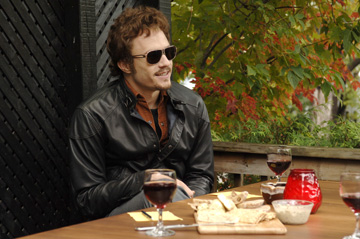 Do you need to know a lot about Dylan going in? Well, it undoubtedly helps. I’m Not There is rife throughout with Dylanalia, and, yes, at times it’s dropped as blatantly as the groaners in Across the Universe: Jude mutters “Just like a woman!” at one point as a punchline, and an LBJ on the wall during a party strangely exclaims “It’s not yellow, it’s chicken.” But, others are more obscure, hidden in the fabric of the film like a crossword puzzle for Dylanophiles. Many of the strange denizens of Gere’s Riddle recall characters in songs or various Dylan incarnations, from the whitefaced troubador at Ms. Henry‘s funeral to the Union solders and passing Lincoln on stilts. As Robbie and Claire (Renaldo and Clara?) have one of those tired, terse phone discussions that signifies the end is near, a movie poster over her shoulder reads “CALICO” (i.e. “Sara,” the “calico sphinx in a scorpio dress (you must forgive me my unworthiness.)“) Or, in the scene accompanying one of Dylan’s masterpieces, “Visions of Johanna,” the Ledger Dylan, a movie star of sorts, is bored on the road and skirt-chasing one of his co-stars. As this goes down, we happen to see some elderly crones in neck braces (“the jelly-faced women all sneeze“), Ledger walking in a museum (“Inside the museum, Infinity goes up on trial“), the Mona Lisa (who “musta had the highway blues, you can tell by the way she smiles“), and the co-star he’s tailing, of course, is named Louise. (“Louise, she’s all right, she’s just near. She’s delicate and seems like the mirror. But she just makes it all too concise and too clear that Johanna’s not here.“)
Do you need to know a lot about Dylan going in? Well, it undoubtedly helps. I’m Not There is rife throughout with Dylanalia, and, yes, at times it’s dropped as blatantly as the groaners in Across the Universe: Jude mutters “Just like a woman!” at one point as a punchline, and an LBJ on the wall during a party strangely exclaims “It’s not yellow, it’s chicken.” But, others are more obscure, hidden in the fabric of the film like a crossword puzzle for Dylanophiles. Many of the strange denizens of Gere’s Riddle recall characters in songs or various Dylan incarnations, from the whitefaced troubador at Ms. Henry‘s funeral to the Union solders and passing Lincoln on stilts. As Robbie and Claire (Renaldo and Clara?) have one of those tired, terse phone discussions that signifies the end is near, a movie poster over her shoulder reads “CALICO” (i.e. “Sara,” the “calico sphinx in a scorpio dress (you must forgive me my unworthiness.)“) Or, in the scene accompanying one of Dylan’s masterpieces, “Visions of Johanna,” the Ledger Dylan, a movie star of sorts, is bored on the road and skirt-chasing one of his co-stars. As this goes down, we happen to see some elderly crones in neck braces (“the jelly-faced women all sneeze“), Ledger walking in a museum (“Inside the museum, Infinity goes up on trial“), the Mona Lisa (who “musta had the highway blues, you can tell by the way she smiles“), and the co-star he’s tailing, of course, is named Louise. (“Louise, she’s all right, she’s just near. She’s delicate and seems like the mirror. But she just makes it all too concise and too clear that Johanna’s not here.“)
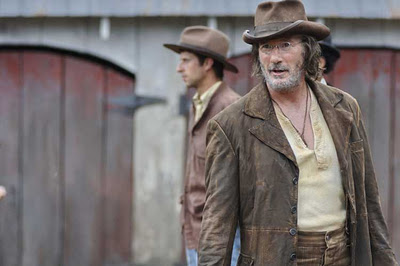 If this all is starting to sound like two and half hours of insufferable inside-baseball for Dylanheads, well, I guess it might be. But I really don’t think it plays like that. (And I also don’t think that was the appeal for me either. Both Masked and Anonymous and Twyla Tharp’s The Times They Are-A Changin’ trafficked in similar inside gags, and I didn’t enjoy those anywhere near as much as this film.) Basically, I’m Not There is too vibrant and enthusiastic to feel smug, remote, or exclusive about its fondness for Dylan. It never purports to define the meaning of any particular song, showing instead that more often than not their beauty lies in their ambiguity. (For example, both defenders of the cultural Old Guard and the Black Panthers feel “Ballad of a Thin Man” is about them.) And it often pokes fun at the Dylanophiles among us, throwing in a number of disgruntled fans at various times (particularly after Bob plugs in) and having Jude get pestered by an overeager amateur Dylanologist after hanging with the Beatles (a very jolly cameo indeed.) Plus, for all the reverence, Dylan himself isn’t as whitewashed as he was in No Direction Home — His drug habit, his youthful arrogance and occasional thin skin, and some questionable views on women poets are all on display here.
If this all is starting to sound like two and half hours of insufferable inside-baseball for Dylanheads, well, I guess it might be. But I really don’t think it plays like that. (And I also don’t think that was the appeal for me either. Both Masked and Anonymous and Twyla Tharp’s The Times They Are-A Changin’ trafficked in similar inside gags, and I didn’t enjoy those anywhere near as much as this film.) Basically, I’m Not There is too vibrant and enthusiastic to feel smug, remote, or exclusive about its fondness for Dylan. It never purports to define the meaning of any particular song, showing instead that more often than not their beauty lies in their ambiguity. (For example, both defenders of the cultural Old Guard and the Black Panthers feel “Ballad of a Thin Man” is about them.) And it often pokes fun at the Dylanophiles among us, throwing in a number of disgruntled fans at various times (particularly after Bob plugs in) and having Jude get pestered by an overeager amateur Dylanologist after hanging with the Beatles (a very jolly cameo indeed.) Plus, for all the reverence, Dylan himself isn’t as whitewashed as he was in No Direction Home — His drug habit, his youthful arrogance and occasional thin skin, and some questionable views on women poets are all on display here.
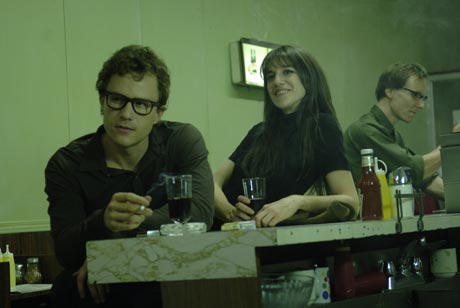 A talented artist in his own right (case in point: Safe and Far from Heaven), Haynes employs all the magic of the movies to tell Dylan’s story. The Robbie-and-Claire scenes are filmed in color occasionally as riotous as in Hayne’s homage to Douglas Sirk, Jack’s social protest and Christian periods are told in faux-documentary fashion, and Jude’s England tour is all black-and-white cinema verite, a la Don’t Look Back. That’s why I’m pretty sure i’m Not There will work even for people who don’t know the first thing about Dylan. It remains visually interesting throughout, and never falls into the usual biopic rut, that standard, hackneyed rise, fall, and rise again narrative which tends to bring down even otherwise well-made entrants in the genre like Walk the Line.
A talented artist in his own right (case in point: Safe and Far from Heaven), Haynes employs all the magic of the movies to tell Dylan’s story. The Robbie-and-Claire scenes are filmed in color occasionally as riotous as in Hayne’s homage to Douglas Sirk, Jack’s social protest and Christian periods are told in faux-documentary fashion, and Jude’s England tour is all black-and-white cinema verite, a la Don’t Look Back. That’s why I’m pretty sure i’m Not There will work even for people who don’t know the first thing about Dylan. It remains visually interesting throughout, and never falls into the usual biopic rut, that standard, hackneyed rise, fall, and rise again narrative which tends to bring down even otherwise well-made entrants in the genre like Walk the Line.
And, of course, it benefits from having one of the better soundtracks out there, and Haynes has expertly weaved Dylan’s music (and some quality cover versions) into almost every moment of the film. Let me put it this way: Within the first five minutes, I’m Not There features some period NYC subway footage set to the irrepressibly toe-tapping “Stuck Inside of Mobile With the Memphis Blues Again.” (Also another visual pun — the subway folk are “stuck inside of mobile.”) From that moment on, the movie pretty had much me. In the end, I don’t know if non-Dylan folk will vibe into it or not, but I found I’m Not There a splendid gift from one Dylan fan to the rest of us, and assuredly one of the more inventive and captivating biopics in recent filmdom. “And the sun will respect every face on the deck, the hour that the ship comes in.“
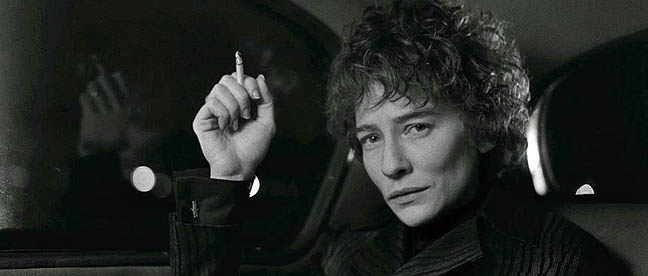
Drivin’ in the flats in a Cadillac Car.
“You know what’s even better than a great road tune? Not having some DJ talkin’ all over it…unless, of course, that DJ is me.” Sigh. On behalf of his XM radio show, Bob Dylan hawks Cadillacs. To be honest, I much preferred when he was pushing ladies’ lingerie. At least that’s a product I can get behind.
Where is the harmony, sweet harmony? (Pst…in Conn!)
So where are the strong? And who are the trusted?> Why, Bob and Elvis, of course, and they’re in the Nutmeg State, or at least they were last night. As promised, I caught the traveling Dylan-Costello tour over the weekend in (relatively) nearby Bridgeport, CT. The setlists:
Elvis: (The Angels Wanna Wear My) Red Shoes | Either Side of the Same Town | Veronica | The River in Reverse | Down Among the Wine and Spirits | Bedlam | From Sulfur to Sugar Cane | Radio Sweetheart/Jackie Wilson Said | (What’s So Funny ‘Bout) Peace, Love and Understanding? | The Scarlet Tide
Bob: Leopard Skin Pill-Box Hat | It Aint Me, Babe | I’ll Be Your Baby Tonight | You’re a Big Girl Now | Rollin’ and Tumblin’ | Workingman’s Blues #2 | ‘Til I Fell In Love With You | When the Deal Goes Down | Honest With Me | Spirit on the Water | Highway 61 Revisited | Nettie Moore | Summer Days | I Shall Be Released
Encore: Thunder on the Mountain | Like a Rolling Stone
Taking the second act first (well, third — as in Bob’s Beacon stand in 2005, Amos Lee was the *real* opener), Bob’s set — as you can see — was heavy on the Modern Times, which is an album I never really listened to all that much. (It came out just before I was kicked to the curb last year, at which point it just got consigned to the iPod shuffle dustbin.) And, as I’ve said before, when it comes to new Bob, I prefer the looming darkness of Time Out of Mind to the rockabilly antics of Love & Theft, which was also represented here a few times. Still, there were a few gems interspersed throughout the set. Bob’s post-apocalyptic croak these days doesn’t really suit tender ditties like “I’ll Be Your Baby Tonight,” and on “I Shall Be Released” I was thinking it might even be time to go the Leonard Cohen backup-singer route. But he still got a fair amount of mileage out of “Like a Rolling Stone” and the raucous opener, “Leopard Skin Pill-Box Hat,” and he looked spry as ever while playing most of the new stuff. Plus on this, my eighth Dylan show (1, 2, 3, 4, 5, 6, 7), I happily got to scratch off “You’re a Big Girl Now” on my own mental checklist of songs to hear the man play live. And, while I’m not sure last night’s version quite did the song justice — A line like “I’m going out of my mind with a pain that stops and starts!” needs the plaintive howl of 1975, not the world-weary rasp of 2007 — I was glad to hear it made the list regardless.
If I’m being a bit harder on Dylan than usual, it may be because Elvis had just left the building, and he pretty much tore the roof off the place in his set. When I heard he was on the bill, I was wondering who his back-up band might be: The Attractions, The Imposters, or some other permutation thereof. Well, as it turned out, this was a solo stand: just Elvis in black, a few guitars, a spotlight, a microphone, ten chords, and the truth. He played more of his standards when I saw him at the Beacon, but that wasn’t a problem here; His too-brief set included a few well-known hits (“Veronica,” “PLU”), some golden oldies (“(The Angels Wanna Wear My) Red Shoes”, “Radio Sweetheart”), some as-yet-unreleased songs (“Down Among the Wine and Spirits,” “From Sulfur to Sugar Cane”), and even a cover of Van Morrison’s “Jackie Wilson Said,” and each one burned with clarity and conviction. Among the highlights for me were “Either Side of the Same Town,” my favorite song from The Delivery Man, “The River in Reverse” (from his album with Alan Toussaint — it was a blistering call-and-response number last night), and the anti-war lament “The Scarlet Tide” (also from Delivery Man.) (To his credit, Costello also had a remarkable amount of Bridgeport-specific stage patter last night, from name-dropping the old arena there to paying respect to the father of show business, Bridgeport native P.T. Barnum. Somebody had done his homework.)
Yes, I received your letter yesterday.
Johnny’s in the basement, mixing up the medicine, I’m on the pavement, thinking about the government. And Tessa? Well, she’s sending me this swanky link to the new Dylan messaging site, where you can create your own version of the seminal 1965 Subterranean Homesick Blues video. (Also up here is the video for Mark Ronson’s brand new remix of “Most Likely You’ll Go Your Way (And I’ll Go Mine.)” I’m not sold on the horn section, to be honest, but it’d be hard to improve on Blonde on Blonde in any event. Time will tell, just who fell, and who’s been left behind…)
The ghost of ‘lectricity howls in the bones of her face.
In case you missed it or were otherwise dissuaded by the lousy format last time, the teaser for Todd Haynes’ off-kilter Bob Dylan biopic I’m Not There is now officially online, along with a new red-band trailer for Robert Zemeckis’ stab at Beowulf. Definitely catching the former, probably seeing the latter.
Zimmerman/McManus.
A tour to look out for: The freewheeling Bob Dylan is, as ever, on the road, but this September and October he’s bringing along Elvis Costello to boot. I’ve seen Bob a lot, and I’ve seen Elvis, but seeing ’em back-to-back should be more fun than you can shake a stick at. (I’m definitely going to the Bridgeport, CT show…undecided about Albany.)
Jokerman.
As you can see, Heath Ledger’s been busy. First off, new pics surface of Ledger and others as Bob Dylan in I’m Not There, including more images of Cate Blanchett eerily channeling the Blonde on Blonde-era Bob. (See below and here for more.) And, apparently much to the consternation of the Time Warner powers-that-be, eighteen early and spoilerish stills from Christopher Nolan’s The Dark Knight have leaked onto the Internets, including a few of Ledger’s Joker seeming to enjoy a police interrogation more than he probably should. Check ’em out before they disappear.
Bob, Woody, Dewey.
Speaking of I’m Not There, the Todd Hayne’s new Dylan biopic has a teaser out, where you can catch brief glimpses of all the varied permutations of Bob. (Blanchett, Bale, Ledger, Gere, Whishaw, et al.) And, also in the trailer bin, Woody Allen ventures back into Match Point territory with Ewan MacGregor, Colin Farrell, Tom Wilkinson, and newcomer Hayley Atwell in the new (French-subtitled) preview for Cassandra’s Dream. And John C. Reilly brings to life one of Dylan’s formative influences in the parody-heavy trailer for Walk Hard: The Dewey Cox Story, brought to you by the Freaks & Geeks team of Jake Kasdan and Judd Apatow and also starring Jenna Fischer, Kristen Wiig, and Tim Meadows (as well as Jack White as Elvis and Paul Rudd, Jack Black, Mac Guy, and Jason Schwartzman as John, Paul, George, and Ringo.)
But he breaks like a little girl.
She’s got everything she needs, she’s an artist, she don’t look back. (Although if I had to guess, she’s been watching the heck out of Don’t Look Back lately.) With (a non-levitating) Bruce Greenwood in tow, Cate Blanchett channels Blonde on Blonde-era Dylan and meets never-nude Allen Ginsburg (David Cross) in this brief You-tubed clip from Todd Haynes’ forthcoming I’m Not There. Other Dylans in the production: Christian Bale, Marcus Carl Franklin, Richard Gere, Heath Ledger, and Ben Whishaw.

